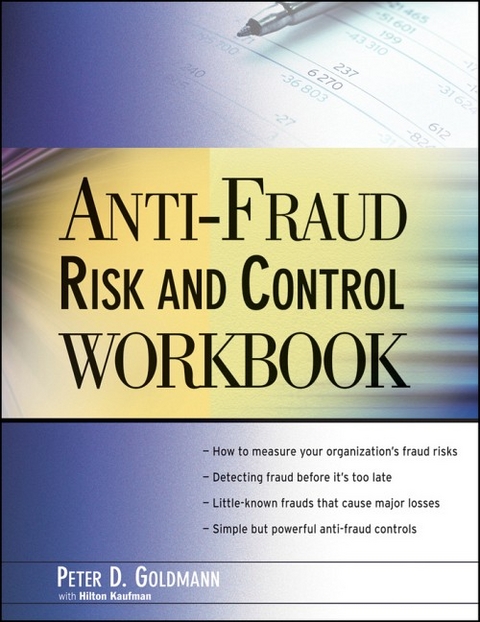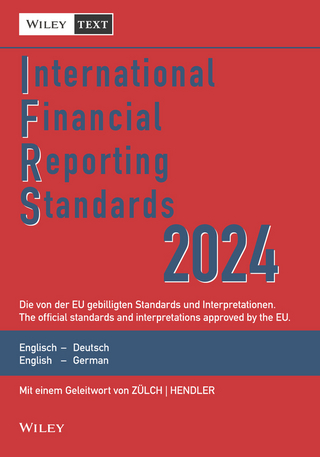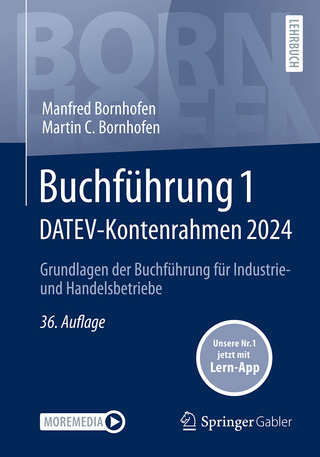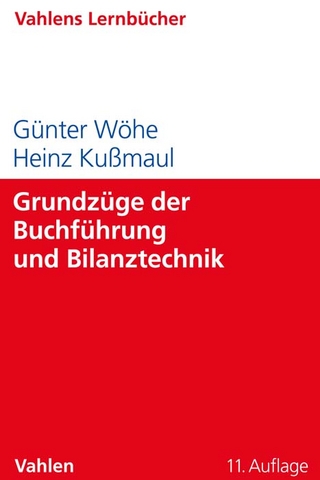
Anti-Fraud Risk and Control Workbook
John Wiley & Sons Inc (Verlag)
978-0-470-49653-4 (ISBN)
- Lieferbar (Termin unbekannt)
- Versandkostenfrei innerhalb Deutschlands
- Auch auf Rechnung
- Verfügbarkeit in der Filiale vor Ort prüfen
- Artikel merken
How to measure your organization's fraud risks Detecting fraud before it's too late Little-known frauds that cause major losses Simple but powerful anti-fraud controls
Proven guidance for fraud detection and prevention in a practical workbook format
An excellent primer for developing and implementing an anti-fraud program, Anti-Fraud Risk and Control Workbook engages readers in an absorbing self- paced learning experience to develop familiarity with the practical aspects of fraud detection and prevention.
Whether you are an internal or external auditor, accountant, senior financial executive, accounts payable professional, credit manager, or financial services manager, this invaluable resource provides you with timely discussion on:
Why no organization is immune to fraud
The human element of fraud
Internal fraud at employee and management levels
Conducting a successful fraud risk assessment
Basic fraud detection tools and techniques
Advanced fraud detection tools and techniques
Written by a recognized expert in the field of fraud detection and prevention, this effective workbook is filled with interactive exercises, case studies, and chapter quizzes and shares industry-tested methods for detecting, preventing, and reporting fraud.
Discover how to become more effective in protecting your organization against financial fraud with the essential techniques and tools in Anti-Fraud Risk and Control Workbook.
PETER D. GOLDMANN is founder and President of White-Collar Crime 101 LLC, the parent company of FraudAware and publisher of the monthly newsletter, White-Collar Crime Fighter. He has been the Publisher and Editor of White-Collar Crime Fighter for over twelve years and is recognized as a leading expert in the areas of fraud detection, prevention, investigation, and training. He has written numerous articles on practical approaches to fraud prevention and detection.
Preface vii
A Short History of Fraud viii
About This Book x
About White-Collar Crime 101 LLC xi
Acknowledgments xiii
Chapter 1 Why No Organization Is Immune to Fraud 1
What Is Fraud? 2
Myths and Realities about Fraud
Myth #1: Ethics and Compliance Training “Has Us Covered” 3
Myth #2: Our Finance Staff Are Qualified to Protect us Against Fraud 4
Myth #3: We Have Very Little Fraud Here 4
Myth #4: Fraud Is a Necessary Cost of Doing Business 5
Myth #5: Implementing Controls and Training Is Costly 6
The Urgency of Detecting and Preventing Fraud 6
Tone at the Top 7
Review Points 8
Chapter Quiz 9
Chapter 2 The Human Element of Fraud 11
Who Commits Internal Fraud? 12
The Fraud Personality: Soft Indicators 12
The Fraud Personality: Hard Indicators 14
Why People Steal 14
The Fraud Triangle 15
Case Study #1: Pain, Pills, and Petty Cash 16
Other Fraud Triangle Factors 18
A Triangle or a Diamond? 18
The Trust Factor 19
Case Study #2: The Trusted Thief 19
People: The Key to Detection and Prevention 20
Case Study #3: Demise by Personal Debt 21
Review Points 21
Chapter Quiz 22
Chapter 3 Internal Fraud: Employee Level 25
How Big a Problem Is Internal Fraud? 25
Overview of Employee-Level Fraud 26
Embezzlement 26
Accounts Payable (AP) Fraud 27
Case Study #4: Shell Game in the Big Apple 28
Case Study #5: Health Care Fraud 31
Accounts Receivable Fraud 32
Case Study #6: Robbing Peter to Pay Paul 33
Kickback Schemes 33
Inventory/Supply Schemes 33
Case Study #7: Kickbacks Fly When Controls Are Weak 34
Check Fraud and Tampering 35
Travel and Entertainment (T&E) Fraud 39
Payroll Schemes 41
Case Study #8: Wining and Dining on Customer Dollars 41
Theft of Confidential Information 42
Case Study #9: The New Employee 42
Case Study #10: Information Is as Good as Gold 43
Insider Abuse of Computer Systems 44
Case Study #11: But She Was Such a Nice Lady! 44
Red Flags of Employee-Level Fraud 45
Preventing Employee-Level Fraud 49
Accounts Payable Fraud-Prevention Checklist 50
Specific Employee-Level AP Fraud Controls Checklist 51
P-Card Fraud-Prevention Checklist 53
Accounts Receivable Fraud-Prevention Checklist 55
Kickback Scheme Prevention Checklist 55
Inventory Theft and Fraud-Prevention Checklist 56
Check Fraud-Prevention Checklist 56
ACH Fraud-Prevention Checklist 57
T&E Fraud-Prevention Checklist 57
Payroll Fraud-Prevention Checklist 58
Confidential Information Theft Prevention Checklist 58
Review Points 59
Chapter Quiz 61
Chapter 4 Internal Fraud: Management Level 67
T&E Fraud and Abuse 67
Bribery 70
The Greatest Corruption Story of All Time 72
Conflicts of Interest 73
Case Study #12: Brenda Belton’s Conflict of Interest Scheme 74
Misuse of Organization-Owned Assets 74
Fraudulent Financial Reporting 75
Case Study #13: The Great Buca Restaurant Fraud 77
Red Flags of Management-Level Fraud 78
Preventing Management-Level Fraud 81
Anti-Embezzlement Controls 82
Bribery and Kickback Schemes 84
Abuse of Organization-Owned Assets 84
Conflicts of Interest 84
Financial Statement Fraud 85
Review Points 89
Chapter Quiz 89
Chapter 5 External Fraud: Protecting Against Dishonest Outsiders 93
Types of External Fraud 93
Vendor and Billing Fraud 93
Social Engineering and Pretexting 95
Case Study #14: The Phoner Toner Scam 97
Bank Employee Collusion with Outsiders 97
Case Study #15: The Frito Fraud 98
Customer-Perpetrated Fraud 98
Theft of Confidential Information 99
The “SCAM” Model 100
Red Flags of External Fraud 101
Preventing External Fraud 103
Review Points 105
Chapter Quiz 106
Chapter 6 Conducting a Successful Fraud Risk Assessment 109
Procedures for Conducting a Fraud Risk Assessment 111
Step 1: Create an FRA Team 111
Step 2: Identify the Organization’s Universe of Potential Risks 111
Step 3: Analyze the Likelihood of Each Scheme or Scenario Occurring 113
Step 4: Assess the Materiality of Risk 113
Step 5: Assess Risks within the Context of Existing Anti-Fraud Controls 113
The Roles of the Board and Management in Fraud Risk Assessments 114
Review Points 115
Chapter Quiz 116
Chapter 7 Basic Fraud Detection Tools and Techniques 119
Basic Fraud Detection 120
Case Study #16: I’m the Boss, and I Can Use Any Vendors I Want 125
Review Points 126
Chapter Quiz 127
Chapter 8 Advanced Fraud Detection Tools and Techniques 129
Internal Audit and the Audit Plan 129
Essentials of Fraud Auditing 131
Auditing for Fraud in Accounts Payable 132
Auditing for Payroll Fraud 133
Essentials of Automated Auditing 135
Review Points 136
Chapter Quiz 137
Appendix A Answers to Chapter Quizzes 139
Appendix B Answer Key for Case Studies 143
Appendix C An Introduction to Cyber Fraud 149
Resources 163
Notes 165
Glossary 171
About the Author 175
Index 177
| Erscheint lt. Verlag | 30.7.2009 |
|---|---|
| Zusatzinfo | Drawings: 13 B&W, 0 Color |
| Verlagsort | New York |
| Sprache | englisch |
| Maße | 217 x 279 mm |
| Gewicht | 467 g |
| Einbandart | Paperback |
| Themenwelt | Wirtschaft ► Betriebswirtschaft / Management ► Rechnungswesen / Bilanzen |
| ISBN-10 | 0-470-49653-3 / 0470496533 |
| ISBN-13 | 978-0-470-49653-4 / 9780470496534 |
| Zustand | Neuware |
| Haben Sie eine Frage zum Produkt? |
aus dem Bereich


